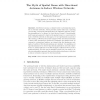Free Online Productivity Tools
i2Speak
i2Symbol
i2OCR
iTex2Img
iWeb2Print
iWeb2Shot
i2Type
iPdf2Split
iPdf2Merge
i2Bopomofo
i2Arabic
i2Style
i2Image
i2PDF
iLatex2Rtf
Sci2ools
PAM
2010
Springer
2010
Springer
The Myth of Spatial Reuse with Directional Antennas in Indoor Wireless Networks
Abstract. Interference among co-channel users is a fundamental problem in wireless networks, which prevents nearby links from operating concurrently. Directional antennas allow the radiation patterns of wireless transmitters to be shaped to form directed beams. Conventionally, such beams are assumed to improve the spatial reuse (i.e. concurrency) in indoor wireless networks. In this paper, we use experiments in an indoor office setting of Wifi Access points equipped with directional antennas, to study their potential for interference mitigation and spatial reuse. In contrast to conventional wisdom, we observe that the interference mitigation benefits of directional antennas are minimal. On analyzing our experimental traces we observe that directional links do not reduce interference to nearby links due to the lack of signal confinement due to indoor multipath fading. We then use the insights derived from our study to develop an alternative approach that provides better interference ...
Related Content
| Added | 18 May 2010 |
| Updated | 18 May 2010 |
| Type | Conference |
| Year | 2010 |
| Where | PAM |
| Authors | Sriram Lakshmanan, Karthikeyan Sundaresan, Sampath Rangarajan, Raghupathy Sivakumar |
Comments (0)

